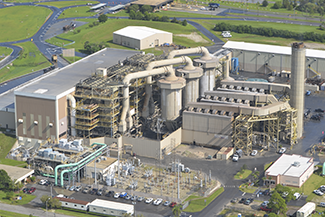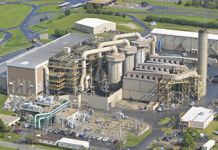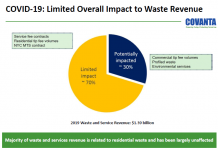by Debra Fiakas, CFA
Waste handler Covanta Holding Company (CVA: NYSE) reported financial results for the first three months of the year at the beginning of May 2020. True enough the net loss might have been wider than published estimates for the quarter, but the consensus target did not reflect a one-time, non-cash charge for asset impairment. Indeed, Covanta’s sales climbed year-over-year to $468 million, of which $61 million was converted to operating cash flow. Waste handling is considered an essential service so Covanta operations remained at full operations even as many of its customers were subject to work stoppages and stay-at-home policies to stop the spread of the coronavirus COVID-19.

The numbers must have triggered a widespread sigh of relief. In early April 2020, when Covanta leadership cut the company’s generous dividend payout, shareholders had apparently expected the worst. The bad news was accompanied by a withdrawal of guidance for 2020 earnings and a warning that policies to deal with the coronavirus could severely impact Covanta revenue. Furthermore employee health and safety would require additional spending, cutting into profits. They promptly took a cleaver to CVA shares, sending the price to historic lows.
In retrospect the dividend cut may seem a bit drastic given how well the company came through the first quarter. That said, the worst of the crisis came later in April and May 2020. To learn how Covanta handled conditions in those weeks shareholders will have to wait until early July 2020, when Covanta reports financial results for the quarter ending June.
Part of the company’s success in the first quarter 2020 was the result of clever negotiations with customers and forward-thinking contracts with price escalators. The company reported same-store average tip fee increases by 5% in the quarter. Much of the company’s tip fee revenue comes from processing residential waste on behalf of municipalities, for which volumes have remained strong.
There are reasons to be cautious in taking a position in CVA. The company is well leveraged with over $2.6 billion in debt on its balance sheet. That represents an exceptionally high debt-to-equity ratio of 843.9. Nonetheless, earnings often trump balance sheet circumstances. Based on cash earnings over the last twelve months Covanta’s interest coverage multiple was 2.4 times at the end of March 2020. This compares well to 2.5 times for the year 2019, but leaves little room for further slippage.
Having prepared for the worst in the first quarter report, shareholders will probably still brace themselves for Covanta’s second quarter results. The company will have been subjected to coronavirus pandemic conditions throughout the entire quarter. Management may have been able to apply lessons learned in the first quarter to help smooth out the worst bumps. Investors appear to believe they will be successful.
The stock has recovered by 37% over the all time low set in April, pushing back up through a line of volume-related price support/resistance at the $8.50 price level. Another good quarter report could move the stock back closer to the pre-crisis level near $15.00.
Neither the author of the Small Cap Strategist web log, Crystal Equity Research nor its affiliates have a beneficial interest in the companies mentioned herein. The author of this article holds a beneficial interest in CVA shares.
This article was first published on the Small Cap Strategist weblog on 6/4/20.








